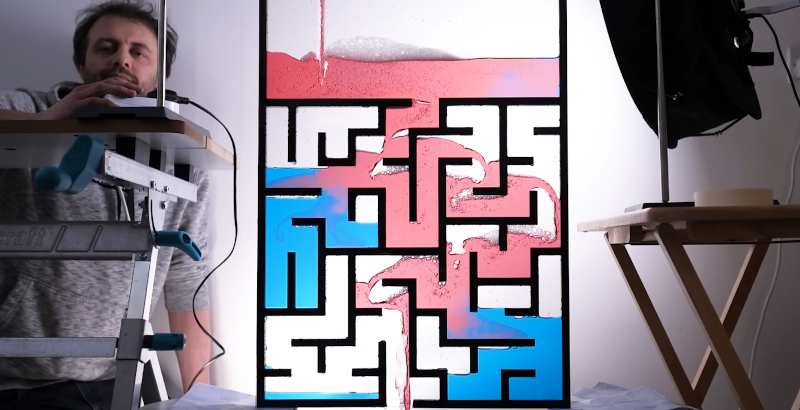We aren’t sure if it qualifies as fluidic logic, but [Steve Mould] was inspired by a simulation of water flowing through a maze and decided to build some actual mazes and watch water flowing through them. It turns out there are several physical effects in play, and you can see [Steve] discuss them in the video below.
The maze, of course, has to be oriented so that water flows into the top and flows out of the bottom. Without much thought, you’d think that the water just goes to the bottom and then fills up. Eventually, the part that is open at the bottom will have water coming out, right? Turns out it isn’t that simple.
A combination of air pressure and surface tension conspire to make the water do better than expected. Not that it perfectly solves it, but it doesn’t just fill up the entire maze, either. Even more interesting is that once the water has found the bottom, changing the water color will clearly show the path through the maze since nearly all of the new colored water will follow the flow path.
Practical? We can’t think of why. But it is a great think piece on how water flows and what sort of forces can affect it.
[Steve] is no stranger to making water work out algorithms, something called fluidic logic.
















Really amazing
I’m not sure why, but this reminds me of that story where they used some sort of fungus to map out the most efficient path and either used that as the basis or overlaid it with the Japanese subway system. The idea that water or single-cell organisms are ‘smart’ wrt efficiency.
Thanks for the heads up, very interesting.
https://www.wired.com/2010/01/slime-mold-grows-network-just-like-tokyo-rail-system/
Slime molds. Sebastian Lague has an excellent (and beautiful) video on YouTube about this style of algorithm.
“has to be oriented so that water flows into the top and flows out of the bottom”
Actually, I don’t think it does – or at least, only so far as the in is on the top and the out is on one of the other three sides (i.e. the input “head” of water must be higher than the exit to allow gravity to do its thing). While the bottom of the maze would start filling first, it would get to a point where the air-pressure prevents it filling entirely and eventually it would start flowing out of an exit orifice.
I suppose that’s true. My point was you couldn’t have, say the entrance and the exit both at the bottom. At least, I don’t think so.
At least, not without significant pressure at the entrance port.
My reply to Al Williams fell to the bottom.. must be my uMatrix script blocker interfering?
The issue was having the entrance and exit both on the bottom.
(copied here from below)
There are plenty of ways to solve that problem:
– Turn the maze upside-down.
– Seal a hose to the bottom entrance connected to pressured line / tank from above.
– Add a corridor from the bottom around to the top.
– use a gas lighter than air.
would love to see this maze solving with smoke instead of water. Lay the maze flat on the table and inject smoke into the entrance, try with differing velocities of smoke.
With a pressure differential between entrance and exit I think the smoke tracer would find the shortest path very quickly.
Definitely not faster than the “water with tension” case. Smoke can mix with air perfectly fine, so even though there’s less air pressure to one side than the other when it hits a fork, the smoke will just mix and displace some of the air in the other side. It’s a little better than that because smoke isn’t really a gas (the soot and small particles will get dragged physically, so it’s definitely not an ‘ideal fluid’ case), but it’s much worse than the water case where tension prevents any significant mixing and the water just traces the air pressure.
If you had some ideal (non-atmospheric) heavier-than-air gas that you could trace via fluorescence or something the flow would be a lot closer to the “simulated water” case, because its partial pressure throughout the maze would be zero.
I wonder if you can make a robot that uses air pressure to find its path. If the maze is sealed you can make the robot seal off a section and push are into it. Based on how the pressure builds up and if it leaks it can detect the length of the path. Maybe it can use echos too. A blind/deaf robot with only a mouth can find its path.
Very interesting !
Maybe he should also review the case where entrance & exit are not on opposite sides or with a non-vertical maze.
It should work even better with Daedalus & Icarus
Why don’t you do it? The construction technique has been shown, looks straightforward and reproducible. State your hypothesis, build something to perform the experiment, show your results.
If you used corn syrup, instead of water, would you be solving a maze with maize?
Very interesting; it is a heuristic computer that solves a problem by first finding the wrong solutions.
There are plenty of ways to solve that problem:
– Turn the maze upside-down.
– Seal a hose to the bottom entrance connected to pressured line / tank from above.
– Add a corridor from the bottom around to the top.
– use a gas lighter than air.